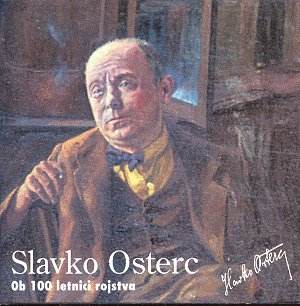The Slovenian Slavko Osterc (1895-1941), along with
Marij Kogoj, is one of the two seminal figures in twentieth-century
Slovenian music. He studied in Prague in the 1920s with Vitezslav Novák
and Alois Habá amongst others and later taught at the Ljubljana
Conservatory until the outbreak of the Second World War. His output
features six operatic pieces (one of which is a mini-opera on the subject
of Salome), five ballets, orchestral and vocal pieces. His instrumental
and chamber output includes pieces for organ, a Saxophone Sonata, a
Sonatina for two clarinets and a 1928 piece for string quartet called
Silhouette, which has been recorded by the Tartini Quartet.
Five of Osterc’s orchestral works are presented here
in recordings which appear, from the inadequate details accompanying
the disc (given only in Slovene, not one of my languages), to date from
between 1965 (the Suite) to 1978 (the Classical Overture). If
so, they have transferred very well. The sound, albeit rather boxy in
fuller textures, is very clear and not as studio-bound as on some recordings
I have heard from more prestigious labels. The performances are, unsurprisingly,
committed, indeed passionate: I cannot really imagine the composer’s
cause being presented in a better light even if a more polished ensemble
like the Concertgebouw were to champion them.
So what of the music itself? Osterc was a contemporary
of Hindemith and a friend of Karl Amadeus Hartmann and there is something
of both to be heard throughout this disc. Hindemith’s shadow is the
longest, particularly in the 1929 Suite written as he finished his studies.
The opening Tempo di marcia might well fool the innocent ear
into thinking it a piece of echt-Hindemith, while the final polyphonic
Presto sounds like an escapee from a lost Kammermusik.
In between, though, come three movements where a little more of Osterc
shines through, especially in the fourth movement, Religioso.
The bright and breezy Classical Overture that opens the disc
dates from 1932 and wears its Hindemith a little more lightly. It would
make an excellent concert opener.
In the Three Dances of 1935, however, we can
hear the composer moving into darker, more personal tonal landscapes.
In this he sounds at times like his colleague Hartmann, but I think
it a matter more of a common reaction to the events of the time rather
than any formative influence. The solo trumpet of the first, Allegro
moderato, and the saxophone solos in the central Valse, are
particularly redolent of the Bavarian’s soundworld, but the main thrust
of the dances themselves are not really Hartmannesque at all. Indeed,
the concluding Vivo looks more to Bartók.
Just how different a composer Osterc was is shown by
the complex Symphonic Movement, composed in 1936, despite—again—some
similarities of instrumentation, though Osterc’s use of the orchestra
is highly imaginative. It is a piece that looks forward more towards
the type of works Hartmann would produce after the Second World War
and makes all the more sad Osterc’s early death in Ljubljana, five weeks
short of his forty-sixth birthday. A hint of what Osterc might have
achieved later is also provided by the Four Symphonic Pieces completed
in 1939. This is the most substantial work on the disc—a succession
of March, Capriccio, Funeral Music and Toccata—and
is indeed a suite and not a symphony (although the model is close to
the Hindemithian model that would appear in post-war works such as the
Sinfonia serena and Sinfonietta in E). Along with the Symphonic
Movement (which at over twelve-and-a-half minutes is the longest
single track), the Four Pieces strongly suggest what an Osterc
symphony might have sounded like. The outer movements are bold and forceful,
though also a reversion to a more Hindemithian mode, separated by the
quixotic Capriccio and the deeply felt Funeral music.
(Whose funeral is not made clear: 1930s Europe, perhaps?)
Slovenian Radio and TV have done us an excellent service
in issuing these works on disc, and it is to be hoped that their series
of music by Slovene composers will receive wider dissemination. Although
a small country, overlooked (indeed historically overpowered from time
to time) by Austria and Italy, Slovenia’s is a thriving musical culture,
not at all inward-looking—they have already heard the Elgar-Payne Third
Symphony, two years ago conducted by Gary Brain—and next year will host
the World Music Days. I hope some Osterc works will be included. They
certainly deserve to be.
Guy Rickards


